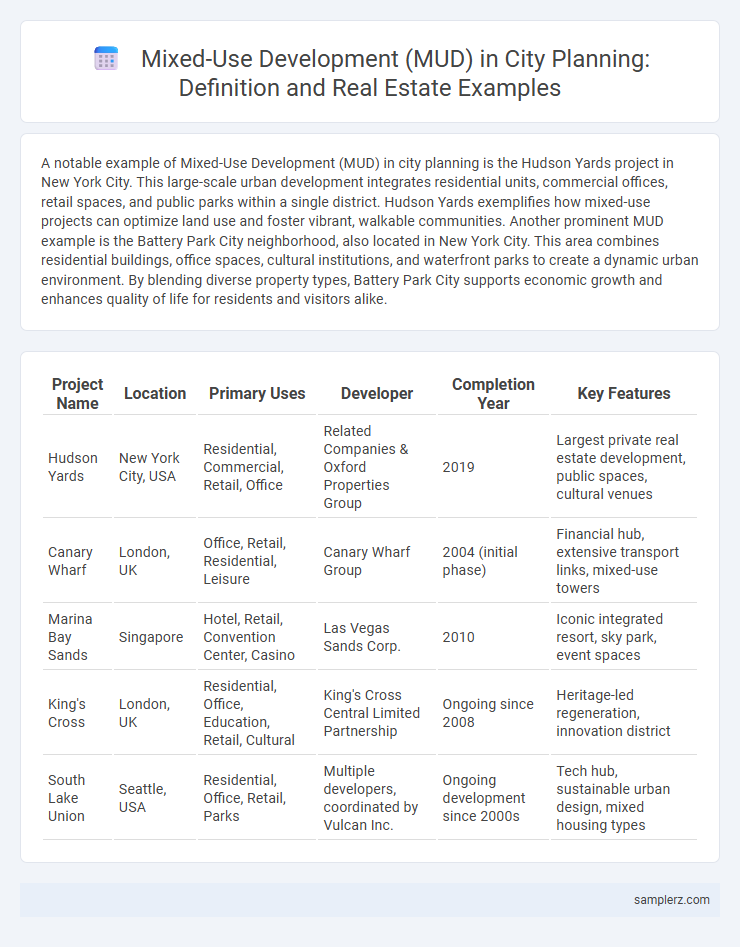A notable example of Mixed-Use Development (MUD) in city planning is the Hudson Yards project in New York City. This large-scale urban development integrates residential units, commercial offices, retail spaces, and public parks within a single district. Hudson Yards exemplifies how mixed-use projects can optimize land use and foster vibrant, walkable communities. Another prominent MUD example is the Battery Park City neighborhood, also located in New York City. This area combines residential buildings, office spaces, cultural institutions, and waterfront parks to create a dynamic urban environment. By blending diverse property types, Battery Park City supports economic growth and enhances quality of life for residents and visitors alike.
Table of Comparison
| Project Name | Location | Primary Uses | Developer | Completion Year | Key Features |
|---|---|---|---|---|---|
| Hudson Yards | New York City, USA | Residential, Commercial, Retail, Office | Related Companies & Oxford Properties Group | 2019 | Largest private real estate development, public spaces, cultural venues |
| Canary Wharf | London, UK | Office, Retail, Residential, Leisure | Canary Wharf Group | 2004 (initial phase) | Financial hub, extensive transport links, mixed-use towers |
| Marina Bay Sands | Singapore | Hotel, Retail, Convention Center, Casino | Las Vegas Sands Corp. | 2010 | Iconic integrated resort, sky park, event spaces |
| King's Cross | London, UK | Residential, Office, Education, Retail, Cultural | King's Cross Central Limited Partnership | Ongoing since 2008 | Heritage-led regeneration, innovation district |
| South Lake Union | Seattle, USA | Residential, Office, Retail, Parks | Multiple developers, coordinated by Vulcan Inc. | Ongoing development since 2000s | Tech hub, sustainable urban design, mixed housing types |
Introduction to Mixed-Use Developments in Urban Planning
Mixed-use developments (MUDs) integrate residential, commercial, and recreational spaces within a single urban area, enhancing land-use efficiency and promoting walkability. Iconic examples like Battery Park City in New York City showcase how mixed-use projects can revitalize urban neighborhoods by combining office towers, retail shops, and housing units. These developments support sustainable city planning by reducing dependency on automobiles and fostering vibrant, cohesive communities.
Key Features of Successful MUD Projects
Successful mixed-use developments (MUD) integrate residential, commercial, and recreational spaces to foster vibrant, walkable communities. Key features include efficient land use, seamless connectivity between zones, and sustainable design elements such as green spaces and energy-efficient infrastructure. Effective MUD projects also prioritize public transportation access and create flexible spaces that adapt to evolving urban needs.
Iconic Mixed-Use Developments Worldwide
Iconic mixed-use developments worldwide, such as Hudson Yards in New York City, exemplify innovative city planning by integrating residential, commercial, and recreational spaces within a single complex. Canary Wharf in London combines office towers, retail centers, and public parks, creating a dynamic urban hub that supports economic growth and community engagement. Other notable examples include Marina Bay Sands in Singapore, which blends luxury hotels, convention centers, and entertainment venues to enhance urban vibrancy and tourism.
Benefits of MUD in City Revitalization
Mixed-use developments (MUDs) such as the Hudson Yards in New York City exemplify how integrating residential, commercial, and recreational spaces revitalizes urban areas. These projects boost economic growth by attracting diverse businesses and residents, increasing property values and tax revenues. MUDs enhance community engagement and sustainability by promoting walkability, reducing traffic congestion, and encouraging efficient land use in city planning.
Case Study: The High Line District, New York City
The High Line District in New York City exemplifies a successful mixed-use development (MUD) by integrating residential, commercial, and public green spaces within a compact urban area. This 1.45-mile elevated park repurposes old railway infrastructure, attracting over 8 million visitors annually and spurring $2 billion in real estate investments nearby. The district's design enhances walkability, supports local businesses, and increases property values, showcasing the economic and social benefits of MUD in city planning.
Sustainable Design in Modern Mixed-Use Projects
Sustainable design in modern mixed-use developments integrates energy-efficient building technologies, green roofing systems, and renewable energy sources to minimize environmental impact. Projects like the Hudson Yards in New York City demonstrate how transit-oriented development and pedestrian-friendly layouts reduce carbon footprints while enhancing urban livability. These developments incorporate water conservation measures and native landscaping to promote ecological balance within densely populated areas.
Integrating Residential, Commercial, and Public Spaces
Mixed-use developments (MUDs) such as Battery Park City in New York City exemplify successful integration of residential, commercial, and public spaces within urban planning. These developments combine high-density housing with retail stores, office spaces, parks, and cultural amenities to create vibrant, walkable neighborhoods. Leveraging proximity to transit hubs, MUDs enhance urban living by promoting accessibility, economic activity, and community engagement.
Challenges in Developing Mixed-Use Urban Areas
Developing mixed-use urban areas such as the Rancho Cucamonga Vineyard Village in California presents complex challenges including zoning conflicts, infrastructure strain, and integration of diverse community needs. Balancing residential, commercial, and recreational spaces demands precise planning to ensure seamless mobility, adequate parking, and environmental sustainability. Effective stakeholder collaboration and adaptive regulatory frameworks are essential to address these multifaceted urban development issues.
Innovations in Mixed-Use Community Layouts
Innovations in mixed-use community layouts feature vertical zoning that integrates residential, commercial, and recreational spaces within a single structure, enhancing land use efficiency. Smart design elements like green rooftops, shared amenities, and pedestrian-friendly pathways foster sustainability and community engagement. Projects such as Hudson Yards in New York exemplify how technology and innovative spatial planning create dynamic, multifunctional urban ecosystems.
The Future of Mixed-Use Developments in Smart Cities
The Hudson Yards project in New York City exemplifies the future of mixed-use developments within smart cities by integrating residential, commercial, and recreational spaces with advanced IoT infrastructure and sustainable design. Advanced data analytics and smart energy systems optimize resource management, reducing carbon footprints and enhancing urban living experiences. This model fosters vibrant, connected communities that adapt dynamically to residents' needs, promoting economic growth and environmental sustainability in metropolitan regions.

example of MUD (mixed-use development) in city planning Infographic
 samplerz.com
samplerz.com